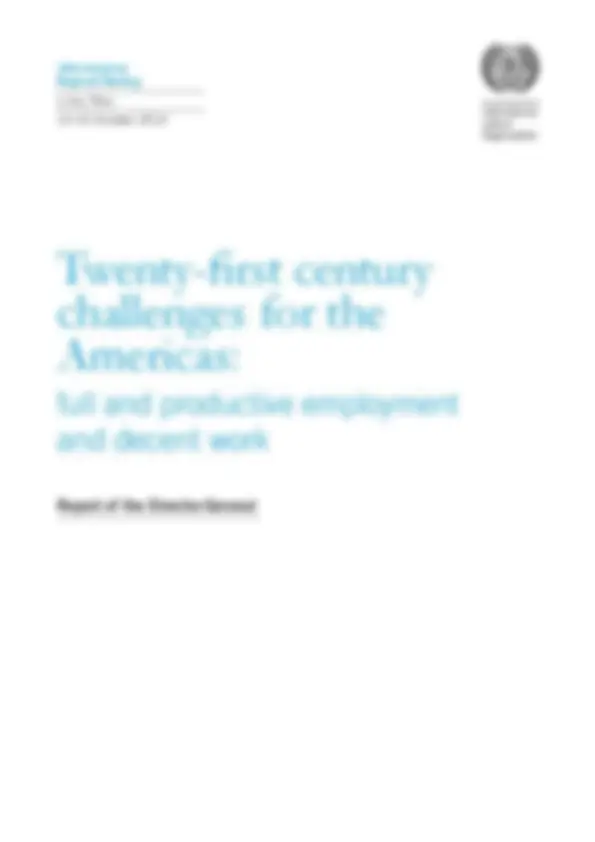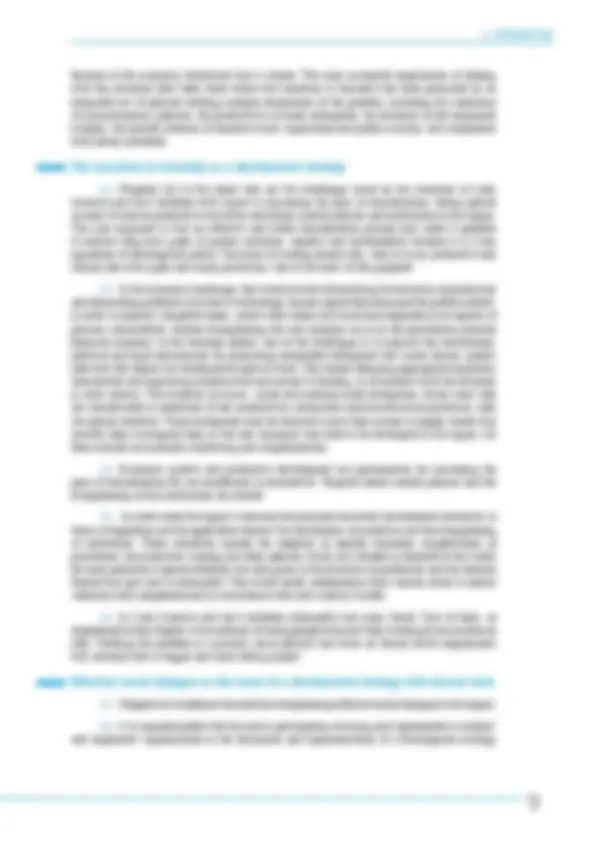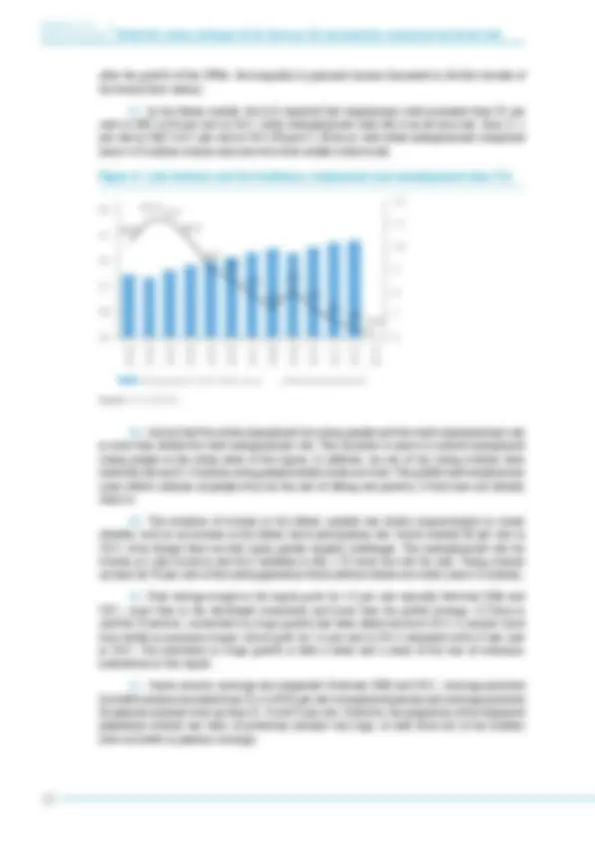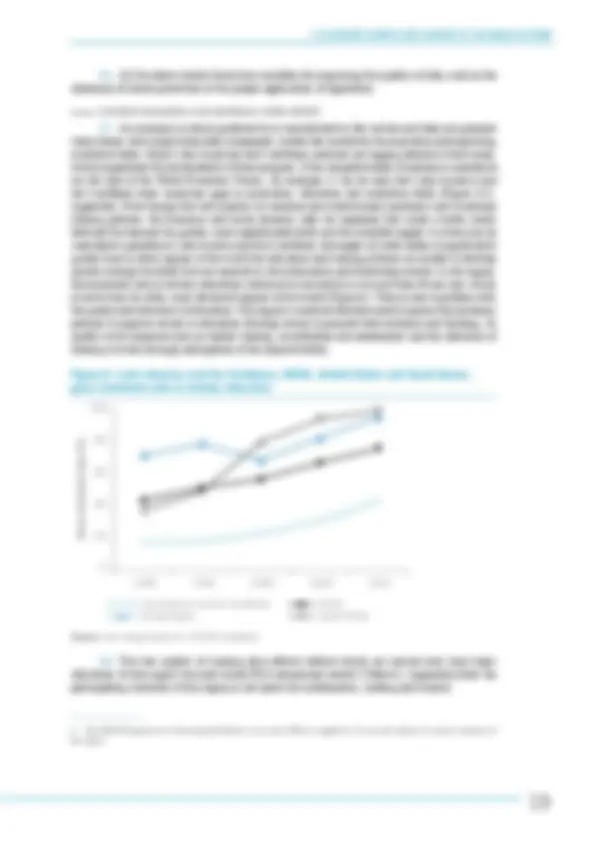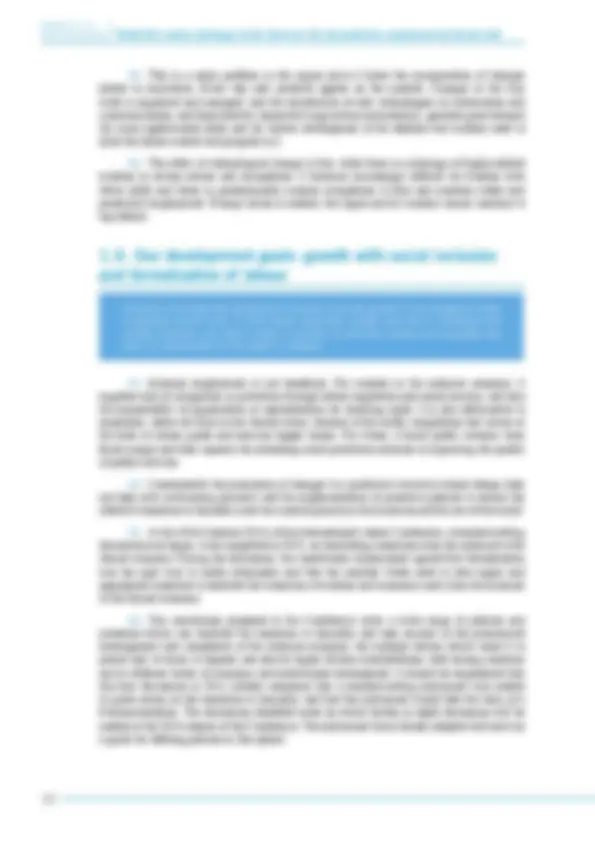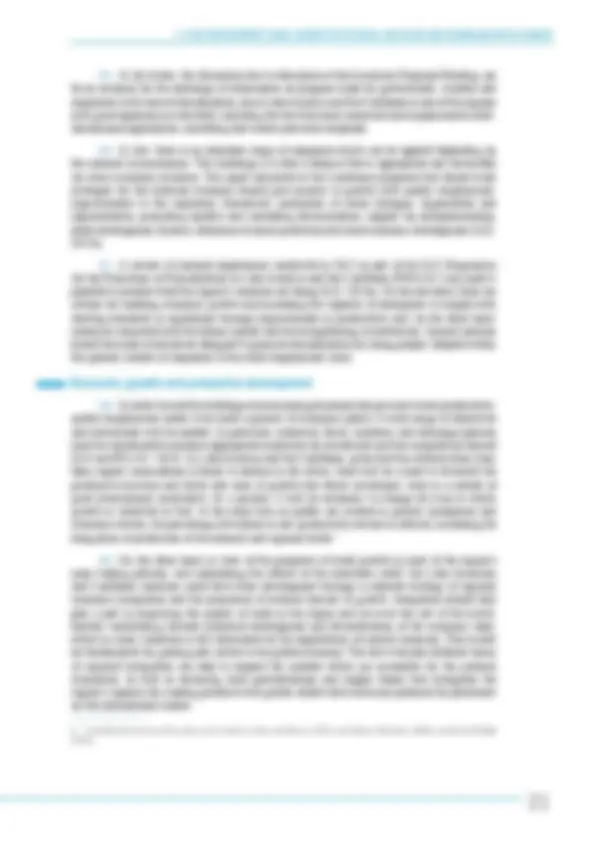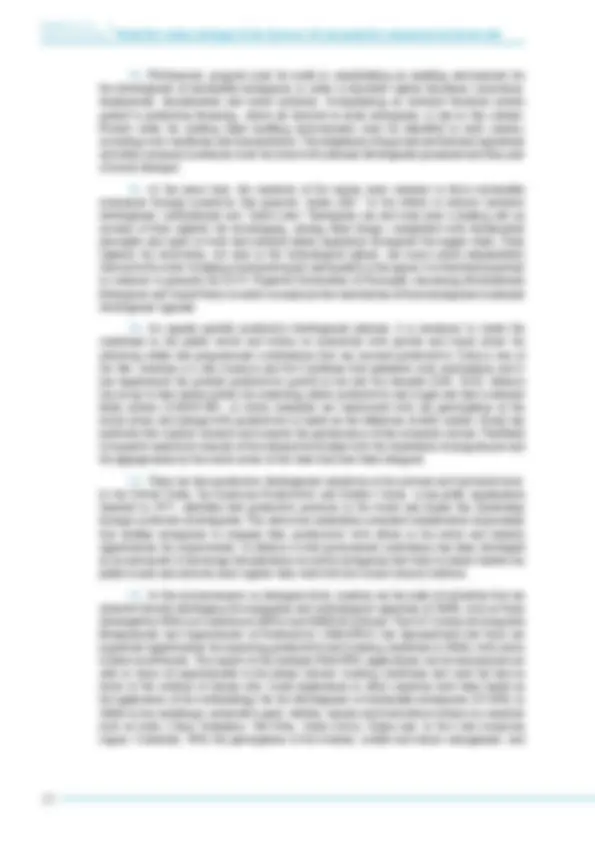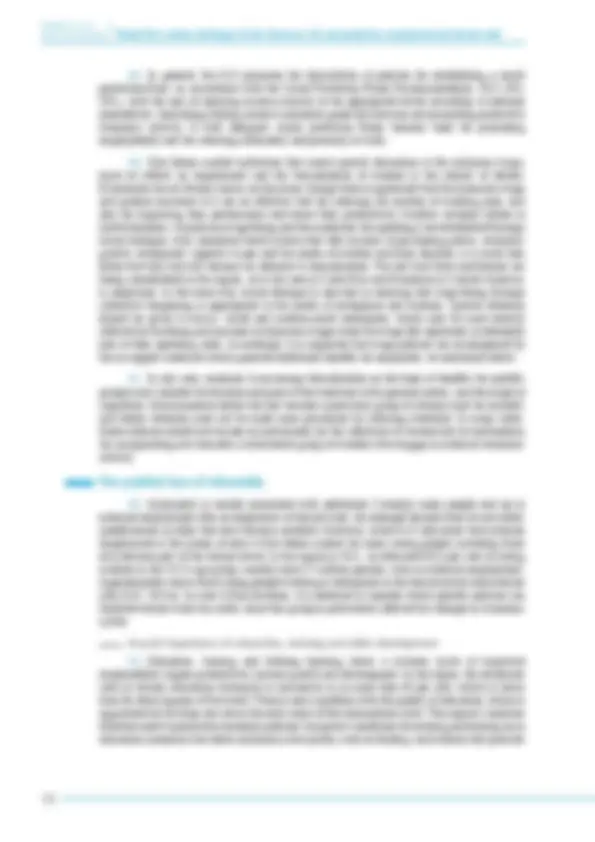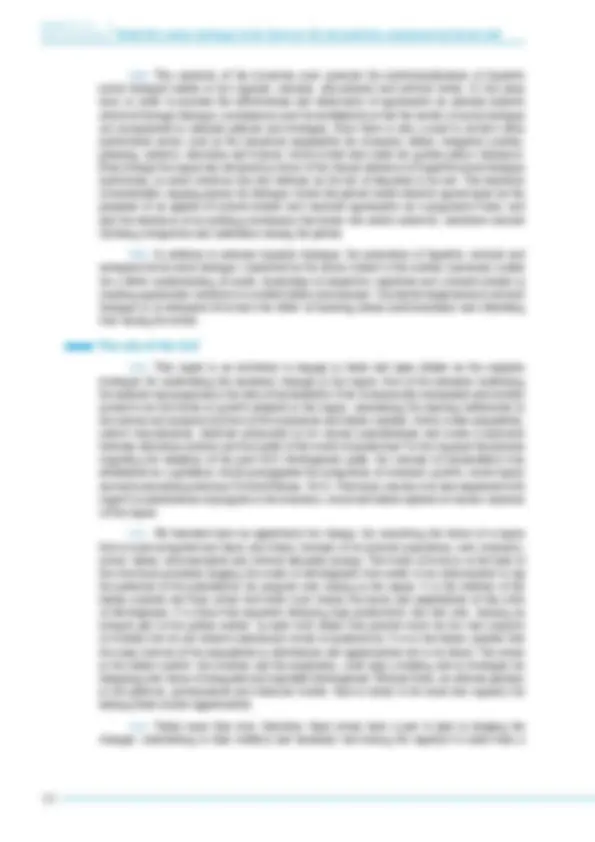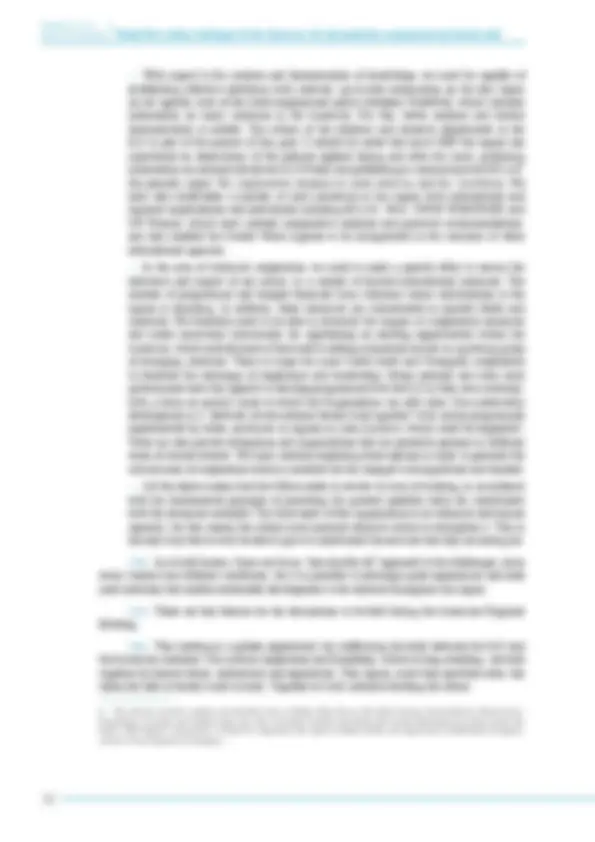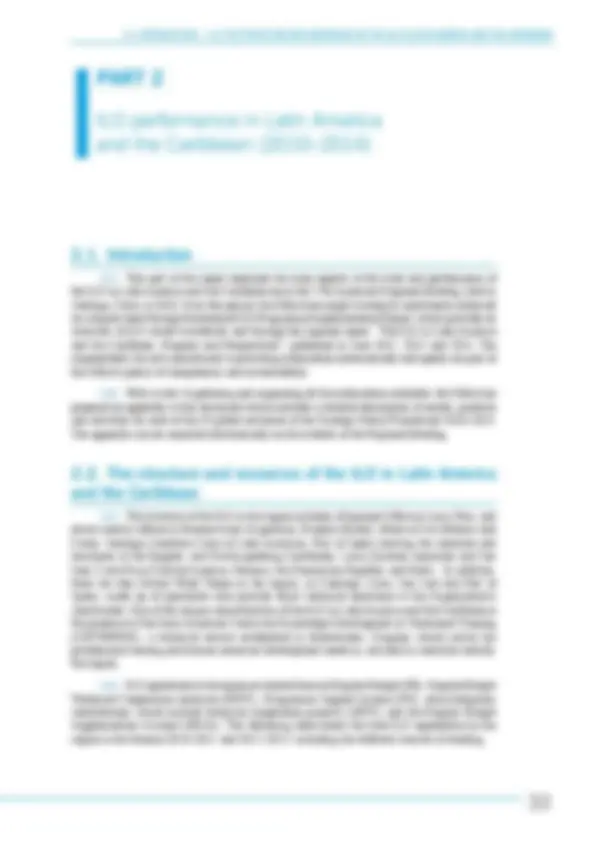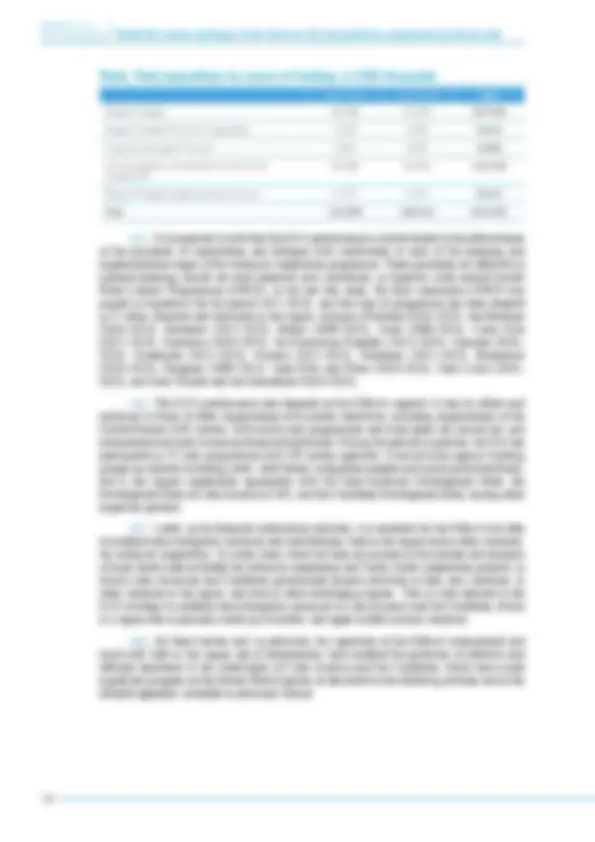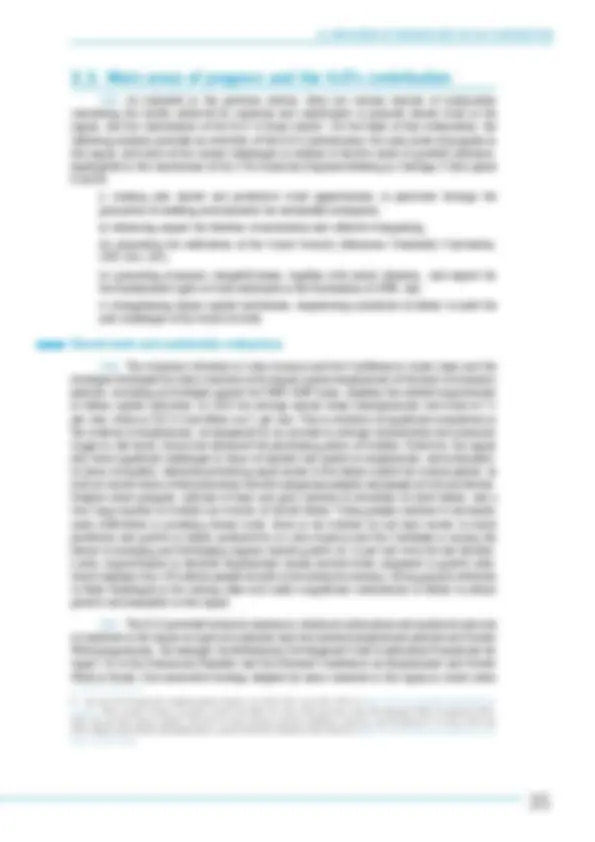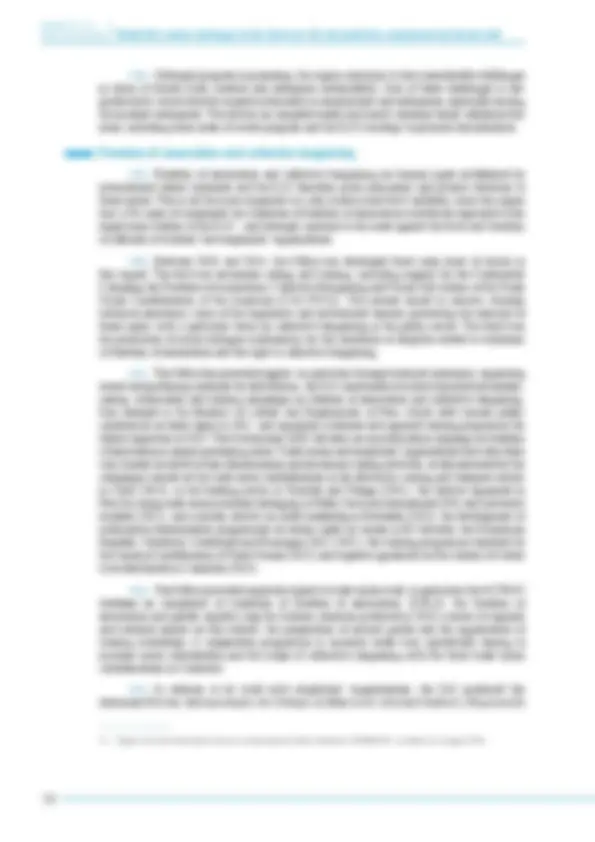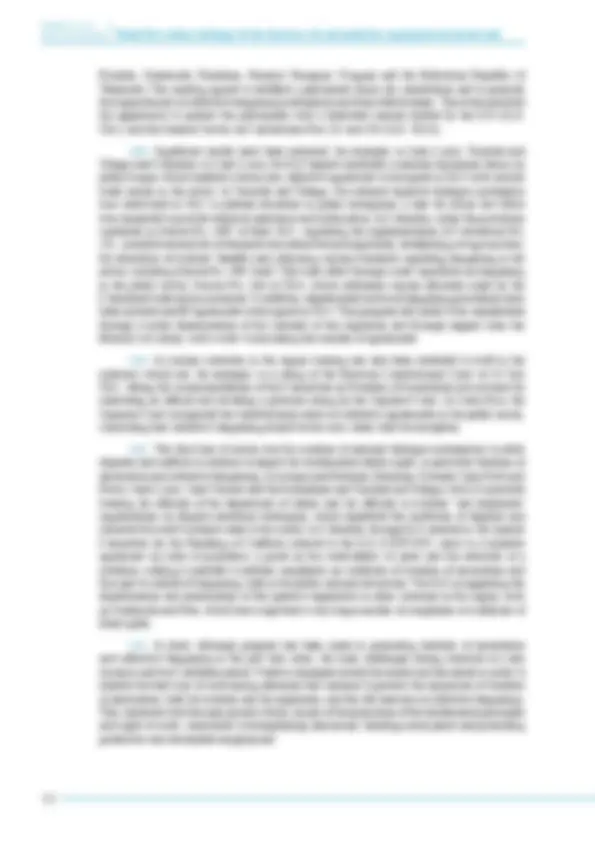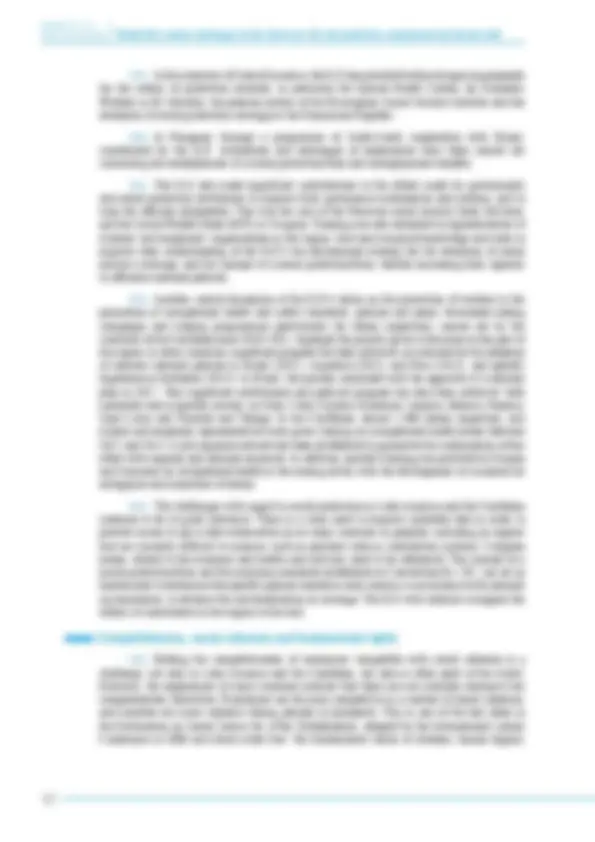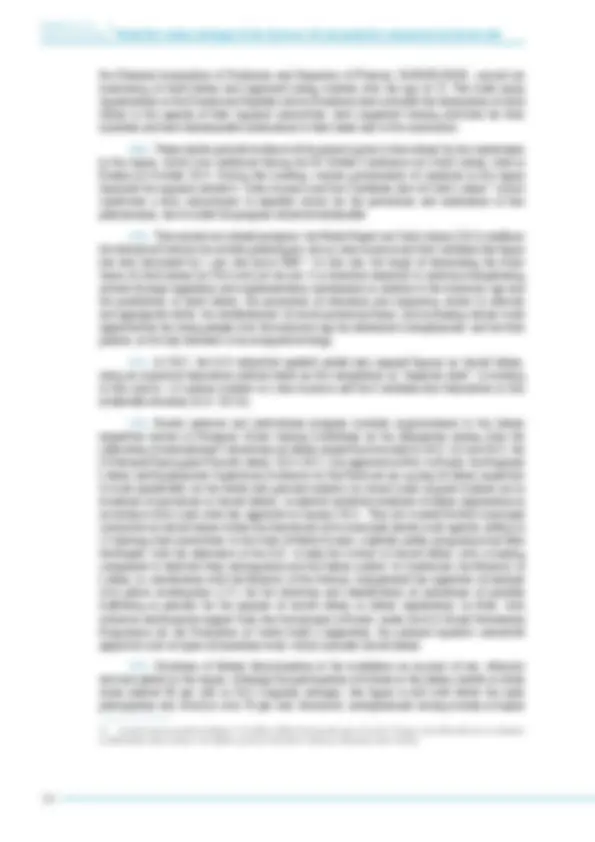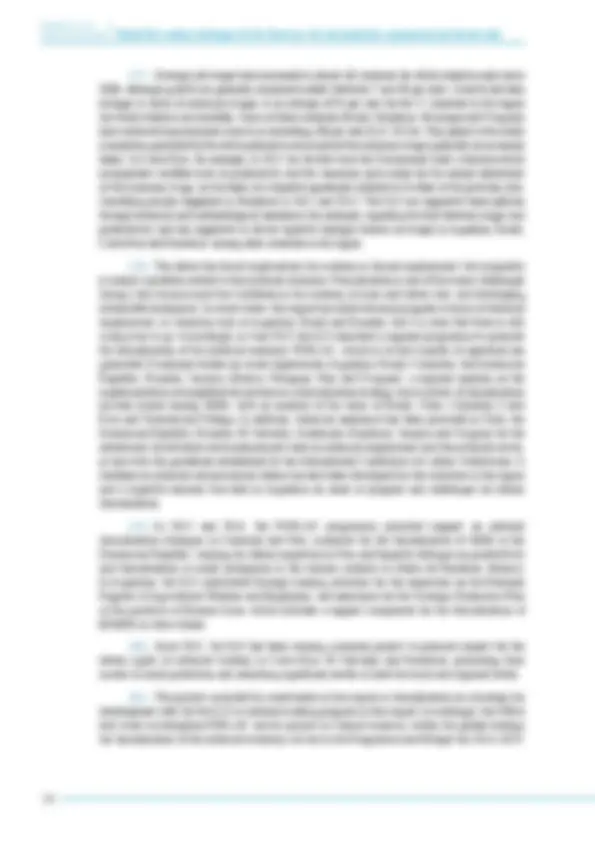Download ILO Publications: Employment Challenges in Latin America & Caribbean in 21st Century and more Lecture notes United States History in PDF only on Docsity!
18th American Regional Meeting
Lima, Peru
13-16 October 2014
Twenty-first century
challenges for the
Americas:
full and productive employment
and decent work
Report of the Director-General
Twenty-first century
challenges for the
Americas:
full and productive employment
and decent work
Report of the Director-General
18th American Regional Meeting
Lima, Peru
13-16 October 2014
Twenty-first century
challenges for the
Americas:
full and productive employment
and decent work
ISBN: 978-92-2-129055-1 (print) ISBN: 978-92-2-129056-8 (web pdf) ISSN: 0251-
First published 2014
The designations employed in ILO publications, which are in conformity with United Nations practice, and the presentation of material therein do not imply the expression of any opinion whatsoever on the part of the International Labour Office concerning the legal status of any country, area or territory or of its authorities, or concerning the delimitation of its frontiers.
Reference to names of firms and commercial products and processes does not imply their endorsement by the International Labour Office, and any failure to mention a particular firm, commercial product or process is not a sign of disapproval.
ILO publications can be obtained through major booksellers or ILO local offices in many countries, or direct from ILO Publications, International Labour Office, CH-1211 Geneva 22, Switzerland. Catalogues or lists of new publications are available free of charge from the above address, or by email: pubvente@ilo. org or biblioteca_regional@ilo.org
Visit our web site: www.ilo.org/publns or www.ilo.org/americas
Printed in Peru
Twenty-first century challenges for the Americas: full and productive employment and decent work
REPORT OF THE DIRECTOR-GENERAL
ABBREVIATIONS
ACT/EMP Bureau for Employers’ Activities (ILO) ACTRAV (^) Bureau for Workers’ Activities (ILO) CARICOM (^) Caribbean Community CINTERFOR Inter-American Centre for Knowledge Development in Vocational Training (ILO) CSA-TUCA Confederación Sindical de Trabajadores y Trabajadoras de las Américas / Trade Union Confederation of the Americas ECLAC Economic Commission for Latin America and the Caribbean (UN) FAO Food and Agriculture Organization of the United Nations FORLAC Programme for the Promotion of Formalization in Latin America and the Caribbean (ILO) GDP Gross Domestic Product IDB Inter-American Development Bank ICT Information and communication technologies ILO International Labour Organization/International Labour Office IMF International Monetary Fund IOE International Organisation of Employers MSMEs Micro, small and medium-sized enterprises OECD Organisation for Economic Co-operation and Development PAHO Pan American Health Organization PISA Programme for International Student Assessment (OECD) PSI Public Services International SCORE Sustaining Competitive and Responsible Enterprises (ILO) SEBRAE Serviço Brasileiro de Apoio às Micro e Pequenas Empresas (Brazilian Micro and Small Business Support Service) SENA Servicio Nacional de Aprendizaje (National Learning Service of Colombia) SENAI Serviço Nacional de Aprendizagem Industrial (National Service for Industrial Learning of Brazil) SIALC Labour Information and Analysis System for Latin America and the Caribbean (ILO) SIMAPRO Integrated System for Measurement and Improvement of Productivity (ILO) SMEs Small and medium-sized enterprises UN United Nations UNDP United Nations Development Programme UNESCO (^) United Nations Educational, Scientific and Cultural Organization UN Women (^) United Nations Entity for Gender Equality and the Empowerment of Women VAT (^) Value-added tax WHO (^) World Health Organization
1.1 INTRODUCTION
PART 1
Twenty-first century challenges for the Americas:
full and productive employment and decent work
1.1. Introduction
- At this first American Regional Meeting for me as ILO Director-General, it is my pleasure to present a report which recognizes the great importance of the Americas region for the Organization, highlights recent progress and draws attention to some areas of concern regarding the capacity of economic growth to create greater social inclusion and quality jobs on the American continent.
- Have the economic models that have been tried and tested in the last 15 years, resulting in moderate but sustained growth, reached their limits? What are the chief obstacles to the creation of greater social inclusion and quality jobs faced by the region’s countries? What are the alternatives and what role should the ILO play in the promotion of substantive and sustainable change? These are the three main questions raised in this paper with the aim of stimulating an open debate and generating ideas to guide the ILO’s action in the immediate future.
- We know that the Americas are a heterogeneous region, where some of the most advanced economies exist alongside emerging economies, a large bloc of middle-income countries and others which are still among the poorest in global terms. Nevertheless, despite their differences, all the countries have accepted and are actively promoting the principles of the Decent Work Agenda, which has been incorporated in discourse and action in the Americas as in no other part of the world. This is reflected in general support for the ILO’s work from governments, workers’ organizations and employers’ organizations, support which is reaffirmed in the form of recognition of its contributions and in constructive criticism which helps both the Organization and the Office to grow.
- The 2014 American Regional Meeting is taking place at a time of global uncertainty. The slow recovery of the world economy, which has been uneven and volatile, is still not having a visibly positive impact on employment or on the welfare of the majority of the population. The countries of the Americas are no strangers to this situation, which has resulted in greater inequality in the United States and Canada and a slowdown in recent positive trends in emerging and developing countries. In Latin America and the Caribbean, the significant progress made in the last decade in reducing poverty, including extreme poverty, and unemployment might be reaching its limit, determined by both the international context and the characteristics of the region’s economies.
- The progress made in recent years by the countries of Latin America and the Caribbean should be recognized and celebrated, as should the recent positive trend in the performance of the labour market in the United States and Canada. At the same time, vigilance is called for regarding the signs of a change in the economic cycle which is having diverse effects on the Americas, with a clear tendency towards a slowdown in the case of Latin America and the Caribbean, and also as regards the persistence of certain major problems affecting the development of the continent.
1.1 INTRODUCTION
because of the economic distortions that it creates. The most successful experiences of dealing with this situation have been those where the transition to formality has been promoted by an integrated set of policies tackling multiple dimensions of the problem, including the coherence of macroeconomic policies, the productivity of small enterprises, the situation of self-employed workers, the specific features of domestic work, registration and public scrutiny, and compliance with labour standards.
The transition to formality as a development strategy
- Chapter 1.3 of the report sets out the challenges faced by the countries of Latin America and the Caribbean with regard to increasing the pace of formalization, taking special account of uneven productive structures and labour market policies and institutions in the region. The core argument is that an effective and stable formalization process will make it possible to achieve long-term goals of greater inclusion, equality and sustainability because it is a key ingredient of development policy. The issue of creating decent jobs –that is to say, productive and formal jobs with rights and social protection– lies at the heart of this proposal.
- In the economic landscape, this would involve diversifying the structure of production and eliminating problems of access to technology, human capital formation and the global markets, in order to improve competitiveness, create value chains and overcome dependency on exports of primary commodities, thereby strengthening the real economy vis-à-vis the speculation-oriented financial economy. In the business sphere, one of the challenges is to improve the institutional, political and legal environment for promoting sustainable enterprises that create formal, quality jobs with full respect for fundamental rights at work. This entails designing appropriate regulatory frameworks and improving infrastructure and access to funding, in accordance with the situation in each country. The situation of micro-, small and medium-sized enterprises, where most jobs are concentrated in conditions of low productivity, informality and limited social protection, calls for special attention. These enterprises must be boosted to give them access to supply chains that actively help to integrate them in the new dynamics that need to be developed in the region. All these actions are mutually reinforcing and complementary.
- Economic growth and productive development are prerequisites for increasing the pace of formalization but are insufficient in themselves. Targeted labour market policies and the strengthening of key institutions are needed.
- In recent years the region’s countries have pursued numerous formalization initiatives, in terms of legislation and the application thereof, the formulation of incentives and the strengthening of institutions. These initiatives include the adoption of specific standards, simplification of procedures, tax incentives, training and other policies, which are valuable in themselves but would be more powerful if special attention was also given to the structure of production and the features thereof that give rise to informality. This would entail collaboration from various actors to ensure coherence and complementarity in accordance with each country’s needs.
- In Latin America and the Caribbean informality has many facets. One of them, as emphasized in this chapter, is the millions of young people who start their working lives in informal jobs. Tackling this problem is a priority, since policies that focus on formal initial employment will certainly have a bigger and more lasting impact.
Effective social dialogue as the basis of a development strategy with decent work
- Chapter 1.4 underlines the need for strengthening effective social dialogue in the region.
- It is unquestionable that the active participation of strong and representative workers’ and employers’ organizations in the discussion and implementation of a development strategy
Twenty-first century challenges for the Americas: full and productive employment and decent work
REPORT OF THE DIRECTOR-GENERAL
is essential for achieving lasting results. However, there are grounds for concern regarding the depth and effectiveness of social dialogue in the region. Even though the crisis brought the social partners and governments closer together in many countries in the search for consensus on counter-cyclical policies, conflict is more prevalent than agreement at present. Confidence is in short supply. Institutions for dialogue that function effectively and regularly as consultative or advisory bodies are few and far between. Acts of violence against trade union and business leaders and obstacles to the exercise of freedom of association and the right to collective bargaining persist with regrettable frequency in the region’s countries. All this affects the legitimacy and sustainability of policies, with negative consequences for democratic governance.
- Equality with productivity, formalization and social dialogue are the three elements proposed in this Report for driving a style of development that is more inclusive and able to create productive and decent work. The ILO’s commitment in the Americas is apparent in its determination to contribute to the agendas for action emerging in many countries aimed at achieving growth with greater equality, better social protection, more and better jobs and more inclusive societies.
- The promotion of decent work has been and continues to be the way to achieve these goals, as was indicated at the XVIII Inter-American Conference of Ministers of Labour (Medellín, October 2013). Of course this is also a recurrent theme for the ILO constituents. In 2006, at the 16th American Regional Meeting in Brasilia, the Report Decent work in the Americas: An agenda for the Hemisphere, 2006-15 was under discussion. The Report was adopted as a programme for the promotion of decent work, the progress of which was reviewed at the 17th American Regional Meeting (Santiago, 2010). The conclusions of this meeting emphasized the priority of promoting freedom of association, collective bargaining, sustainable enterprises and labour administration, in the context of social dialogue. Part 2 of the present Report includes an overview of the ILO’s recent performance in these spheres of action.
- In order to give substantive and relevant support to the constituents, the international system, and especially the ILO, also needs to have the necessary capacity to support the processes of change in the economies and labour markets. The ILO headquarters reform and the review of field operations point in the same direction, with the purpose of making the Organization more flexible and efficient and bringing it closer to the constituents.
- The region has laid foundations that give grounds for optimism concerning the future of the Americas beyond the uncertainty caused by the current economic situation. It is in the hands of the countries themselves and the actors at the national level to find the way to attain this shared objective, and along the way they will always have the effective and respectful support of the ILO.
1.2. Economic growth and changes in the world of work
The first decade of the twenty-first century will be remembered as a period of significant growth which resulted in substantive social, economic and labour progress in the countries of Latin America and the Caribbean. The challenge now is to make this progress sustainable: the region has reduced poverty, but inequality has only decreased slightly and at least 130 million people are working in conditions of informality.
- In the twenty-first century, the Americas went through three major stages in terms of economic growth. The first (expansion) stage began after the recession in the developed countries and the crisis in Argentina in 2001 and 2002 and lasted until the international crisis of 2008. From
Twenty-first century challenges for the Americas: full and productive employment and decent work
REPORT OF THE DIRECTOR-GENERAL
after the growth of the 1990s, the inequality in personal income decreased in the first decade of the twenty-first century.
In the labour market, the ILO reported that employment rates increased from 52 per cent in 2002 to 56 per cent in 2012, while unemployment rates fell to an all-time low, from 11. per cent in 2002 to 6.2 per cent in 2013 (Figure 2). Even so, total urban unemployment comprised some 14.8 million women and men who were unable to find work.
Figure 2. Latin America and the Caribbean: employment and unemployment rates (%)
10,
11,2 11,
10,
9, 8, 7, 7,
8, 7, 6, 6,4 6,
6
7
8
9
10
11
12
45
48
51
54
57
60
2001200220032004200520062007200820092010201120122013 Employment (left hand axis) Unemployment Source: ILO (2013a).
Almost half the urban unemployed are young people and the youth unemployment rate is more than double the total unemployment rate. This amounts to some 6.6 million unemployed young people in the urban areas of the region. In addition, six out of ten young workers have informal jobs and 21.8 million young people neither study nor work. The global youth employment crisis affects millions of people who run the risk of falling into poverty, if they have not already done so.
- The situation of women in the labour markets has shown improvements in recent decades, such as an increase in the labour force participation rate, which reached 50 per cent in 2013, even though there are still major gender equality challenges. The unemployment rate for women in Latin America and the Caribbean is still 1.35 times the rate for men. Young women account for 70 per cent of the youth population which neither studies nor works (some 15 million).
- Real average wages in the region grew by 1.8 per cent annually between 2006 and 2011, more than in the developed economies and more than the global average, if China is omitted. However, a slowdown in wage growth has been observed since 2013. A similar trend was visible in minimum wages, which grew by 2.6 per cent in 2013 compared with 6.9 per cent in 2012. The slowdown in wage growth is both a result and a cause of the loss of economic momentum in the region.
- Social security coverage also expanded. Between 2000 and 2012, coverage provided by health systems increased from 51.6 to 59.8 per cent of employed persons and coverage provided by pension schemes went up from 51.3 to 60.5 per cent. However, the proportion of the employed population without any form of protection remains very high: at least three out of ten workers have no health or pension coverage.
1.2 ECONOMIC G ROWTH AND CHANGES IN THE W ORLD OF W ORK
- Informal employment decreased from more than 52 per cent in 2005 to 47.7 per cent in 2011, a figure that was maintained in 2012. The rate of growth in formal employment has been less than for economic growth and poverty reduction; this means that many people who were no longer defined as poor in the past decade have informal jobs.
- Various countries have seen the emergence of new middle-income groups with economic, social and cultural expectations that are often only partially satisfied. In many cases, these new population groups are in a highly precarious situation, as they often still work informally. In the event of a drop in growth or change in policy, these people may well regress socially and economically and even return to situations of poverty. This new middle class is not a consolidated social category, being subject to the vagaries of the region’s economy.
The global crisis: effects and lessons learned
- In 2008, the major international crisis developed out of a housing bubble in the United States which then became a global financial crisis when the Lehman Brothers investment bank declared bankruptcy. Immediately afterwards, the financial crisis turned into an economic crisis.
— At the global level 32.2 million jobs were lost (Figure A2, Appendix). — In the United States, the growth in GDP in 2009 was accompanied by a rise in unemployment, which reached almost 10 per cent in October of that year (Figure A3, Appendix). In Canada, unemployment rose from 6.1 per cent in 2008 to 8.3 per cent in
— The Eurozone also experienced the onset of an economic crisis, which subsequently developed into the debt crisis. Unemployment stood at 9.6 per cent in 2009 and reached a peak of 12.3 per cent in 2013. — China was also affected by the crisis but the stimulus package that was adopted enabled the country to make up rapidly for the inadequacy in external demand.
- Latin America and the Caribbean were not left unscathed by the international crisis. The mechanisms of transmission were: (a) trade channels, since the United States, the European Union and China are the region’s principal partners; (b) reductions in the prices of commodities, particularly copper and petroleum; and (c) capital flows which also shrank because of investors’ need for greater security. Certain data show the magnitude of the impact in Latin America and the Caribbean:
— Regional GDP fell by 1.22 per cent from 2008 to 2009; — Investment as a percentage of GDP dropped from 23.7 per cent to 20.6 per cent in 2009 (IMF, 2013); — Unemployment rose from 7.3 per cent in 2008 to 8.1 per cent in 2009 and the employment rate fell by 0.5 per cent.
- The impact of the crisis on the labour markets of the region was not as strong as feared, owing to the implementation of employment-friendly public policies (ILO and ECLAC, 2010). The economy also made a significant recovery in 2010, even though a subsequent slowdown was an observable trend.
- During this crisis, it was noteworthy that many Latin American and Caribbean countries did not turn to adjustment remedies that had a recessionary effect on economic growth, employment and labour rights, as had occurred in previous crises. On the contrary, consensus prevailed to promote counter-cyclical policies to stimulate growth and investment, which were possible in the region because of the macroeconomic stability that had been achieved, the relatively stable growth of those years and the fiscal space available. Labour market measures included the following:
1.2 ECONOMIC G ROWTH AND CHANGES IN THE W ORLD OF W ORK
rate for this indicator has slowed down, even becoming a negative value in the Caribbean countries and Mexico in 2012.
- The reduced momentum expected in the region is also due to a curb on, and a certain reversal of, the prices of basic export commodities, a process that began in 2012 and is expected to continue in 2014 (ILO, 2013a). More than one third of the growth of per capita gross national disposable income in the 2003-11 period was due to improved terms of trade in particular for South American countries (ECLAC, 2013a). Efforts are urgently needed to achieve a sustainable increase in the rate of productive investment, which is still low by international standards. Apart from this, the region’s financial markets also show a high degree of volatility.
- Attention should also be given to the impact of the slowdown in growth on the labour markets and economies of Latin America and the Caribbean. Economic growth is key to improving the quantity and quality of jobs but is not sufficient in itself, especially in periods such as the present where there is a loss of momentum. What we are learning from the past decade is that public policies, at both macroeconomic and microeconomic levels, can make the difference.
Long-term trends
- In addition to the above, the region is undergoing a transformation. Certain long-term trends will strengthen in the future, with significant effects on the labour market.
- On the one hand, Latin America and the Caribbean continue to be in a favourable situation. This is because the dependency ratio –the number of dependants for each breadwinner– has improved. The number of breadwinners is expected to increase until 2025, after which the trend will begin to reverse (Figure A6, Appendix).
- Linked to this is the subject of migration. International migration is a growing phenomenon in Latin America and the Caribbean. In recent years, the volume of migrants –taking only principal destinations into consideration– has risen from some 2 million to more than 21. million.^2 More than 90 per cent of migrants move for labour-related reasons. The number of migrants will continue to increase in the next few decades but it is possible that the composition of migration flows will change. Even though the trend in recent decades has been towards emigration and a negative migration balance, projections indicate that this will stabilize in the coming decades and by mid-century the current negative migration balance is even expected to decrease (Figure A7, Appendix). The fact that the intra-regional migration flow is constantly increasing should also be taken into account.
- Another trend having a major impact on the labour market is access to information technologies. In 2000 there were 13 mobile phones per 100 population; in 2012 there were already more mobile phones than inhabitants, even though growth in coverage has been uneven among countries and, above all, among geographical areas within countries. Internet access has also increased, albeit at a slower pace. In 2000, a total of 4 per cent of the population used the Internet; in 2012 the figure was 43 per cent. If the trend continues, more than 70 per cent will have access to the Internet by the end of the decade (Figure A8, Appendix). This will have significant implications for the way in which the labour markets function, increasing labour productivity by enabling faster work performance and information-sharing (ECLAC, 2010).
Limitations on current growth in Latin America and the Caribbean
- The growth observed in the past decade, which has been positive from all angles, also presents certain limitations which need to be identified to consolidate a process of inclusive development. Despite the progress achieved, the region has not managed to become integrated in
- Estimates based on World Bank Global Bilateral Migration Database.
Twenty-first century challenges for the Americas: full and productive employment and decent work
REPORT OF THE DIRECTOR-GENERAL
the global economy in a more sustained and solid form (Ffrench Davis, 2009). This underlines the importance of strengthening the real economy, facilitating greater diversification in production. It is also necessary to intensify regional integration processes that give rise to larger markets and enable diversification of the productive structure towards sustainable activities which are intensive in the use of knowledge and technologies and create added value and productivity. A more diversified product structure would reduce seasonal and cyclical fluctuations and provide more job opportunities for workers, thereby strengthening the creation of employment, the conditions for formalization and, ultimately, equality. It seems clear that progress must be increasingly geared to having an impact on the productive structure as a whole, seeking to create a new matrix that enables the stated goals to be achieved. If it is only the effects that are addressed, the possibility of formulating a new vision of development is likely to remain unfulfilled.
Low productivity growth
During the last few decades, economic growth in Latin America and the Caribbean has been moderate compared with other regions of the world, with an annual average fluctuating around 3 per cent (Ffrench-Davis, 2009), which is insufficient for achieving sustainable goals of social and labour inclusion. It highlights the low growth in productivity: output per worker increased by just 1.5 per cent annually in the first decade of this century (Figure A9, Appendix), a low rate compared with other emerging and developing regions (Figure 3). As a result, output per worker in the region will be overtaken by the global average in 2014 (ILO, 2013d). Governments and social actors would do well to heed this trend. Productivity growth is a necessary condition, albeit not the only one, for achieving sustainable increases in living standards.
Figure 3. Trends in output per worker in emerging regions
Source: ILO (2013b).
80
100
120
140
160
180
20002001200220032004200520062007200820092010201120122013
Index 2000=
South East Asia and the Pacific Latin America and the Caribbean South Asia
North Africa Middle East Sub-Saharan Africa
Some of the factors associated with low productivity growth in the region are lack of investment and credit, macroeconomic volatility, infrastructure deficits, limited technological innovation, lack of linkage between the education system and the labour market, and inadequate productive development policies. One of the causes that the ILO and other institutions have emphasized is the lack of productive diversification and the poor linkage between economic sectors. For example, Latin America and the Caribbean, compared with the rest of the world, has an export structure that relies heavily on minerals, fuels and agricultural products, with manufacturing contributing only a small share (Figure A10, Appendix). This form of integration in the world is associated with a particular productive structure, with sectors that are highly productive but create few jobs and are poorly linked with the rest (Figure 4).
Twenty-first century challenges for the Americas: full and productive employment and decent work
REPORT OF THE DIRECTOR-GENERAL
share of GDP (functional distribution) decreased instead of increasing in most of the region’s countries (Figure 5).^4
Figure 5. Latin America and the Caribbean: personal and functional income distribution 1990-
40
45
50
55
35
37
39
41
43
1990 1997 2002 2009 Note: The GINI coefficient measures income inequality in labour income (0 indicates complete equality and 100 indicates absolute inequality). Labour share of GDP is the ratio of compensation for each productive input (0 indicates total compensation for capital and 100 total compensation for labour). Source: ILO (2012a).
Labour share (left hand axis)
GINI coefficient for labour income (right hand axis)
- Sustaining recent social progress in the region requires an improvement in working conditions. This can only happen in a sustainable manner if an impact is achieved on the productive and economic matrix that produces informality, among other things. In the ILO’s opinion, most people enter the informal economy not by choice but out of a need to survive and to have access to basic income-generating activities (ILO, 2013e).
- Informal employment is heterogeneous and diverse. It has a disproportionate impact on certain occupational categories: employees in SMEs, workers in domestic service, self-employed workers and auxiliary workers. Eighty per cent of informal employment in the region is accounted for by self-employed workers, domestic workers and employees in small enterprises of up to ten workers. It is in the informal economy that some of the most intolerable forms of labour exploitation and violations of fundamental principles and rights at work are found, such as child labour and forced labour. Informality also reflects patterns of discrimination on various grounds, including sex, age, race, skin colour and HIV status. In informal employment, women outnumber men and young people outnumber adults, and indigenous populations and those of African extraction are also heavily represented. Nor should it be forgotten that although available statistics largely refer to urban settings, informality also exists in rural areas. The consequences of informality are more acute in the rural setting because of the low profile of the State and the limited development of markets and institutions. Few countries have adopted specific measures for promoting effective observance of labour rights in the rural economy (in particular freedom of association and collective bargaining), creating a relative institutional void that contributes towards rural poverty (ILO, ECLAC and FAO, 2012). The rural sector is heterogeneous per se. On the one hand, modern agriculture forming part of the global economy contributes towards productive diversification and creates paid employment, even though it is sometimes criticized for failure to comply with fundamental rights at work. On the other hand, family-based and subsistence agriculture, which accounts for between 30 and 40 per cent of agricultural GDP in the region (FAO and IDB, 2007), is characterized by small volumes of production, limited productivity and low wages, with no means of expression or representation. It is this second type of agriculture that has the highest incidence of informal employment.
- For a more detailed discussion of the theme of distribution in the labour market, see ILO (2014b). Some studies link the decrease in labour share to factors such as technological progress, trade globalization, greater influence of financial markets on the real econo- my, and the decline in workers’ trade union membership and bargaining power (Salazar-Xirinachs, 2013).
1.2 ECONOMIC G ROWTH AND CHANGES IN THE W ORLD OF W ORK
- All the above clearly limits key variables for improving the quality of jobs, such as the extension of social protection or the proper application of legislation.
Limited innovation and workforce skills deficit
An economy in which productivity is concentrated in few sectors and does not generate value chains, with a high informality component, creates few incentives for innovation and improving workforce skills. Many Latin American and Caribbean countries are lagging behind in these areas, which jeopardizes the sustainability of their progress. If the competitiveness of nations is considered via the data of the World Economic Forum, for example, it can be seen that Latin America and the Caribbean show enormous gaps in innovation, education and workforce skills (Figure A12, Appendix). Even though the vast majority of countries have institutional machinery and vocational training policies, the economic and social dynamic calls for responses that create a better match between the demand for greater, more sophisticated skills and the available supply. In what may be considered a paradox in Latin America and the Caribbean, the supply of youth labour is significantly greater than in other regions of the world but education and training systems are unable to develop quickly enough the skills that are required in the information and knowledge society. In the region, the enrolment ratio in tertiary education (technical or university) is no more than 40 per cent, which is lower than for other, more advanced regions of the world (Figure 6). There is also a problem with the quality and relevance of education. The region’s countries therefore need to pursue the necessary policies to improve access to education (through action to promote both inclusion and funding), its quality (with measures such as teacher training, accreditation and assessment) and the relevance of training to work (through anticipation of the required skills).
Figure 6. Latin America and the Caribbean, OECD, United States and South Korea: gross enrolment ratio in tertiary education
Source: own design based on UNESCO database.
0
20
40
60
80
100
1990 1995 2000 2005 2012
Gross enrolment ratio (%)
Latin America and the Caribbean OECD United States South Korea
The low quality of training also reflects deficits which are carried over from basic education. In this regard, the most recent PISA assessment results^5 (Table A1, Appendix) show the participating countries of the region in last place for mathematics, reading and science.
- The OECD Programme for International Student Assessment (PISA) is applied to 15-year-old students in various countries of the region.


